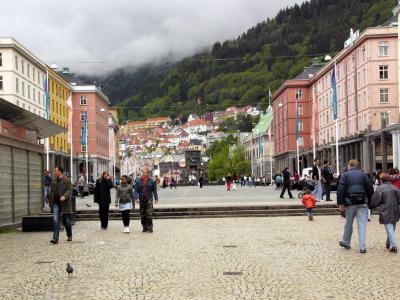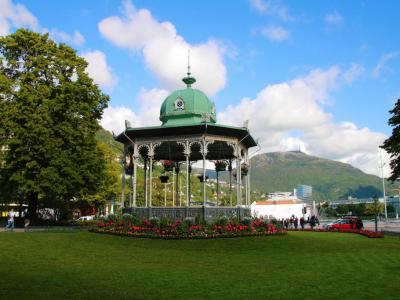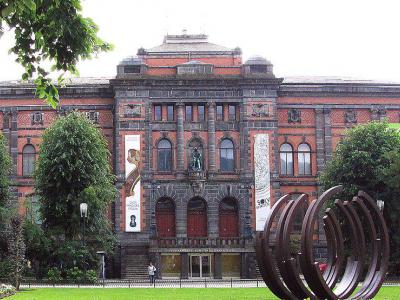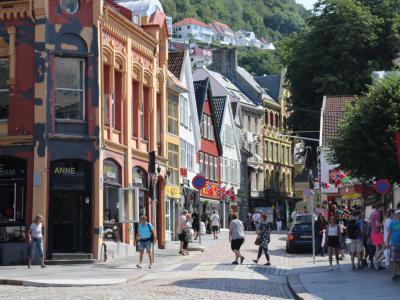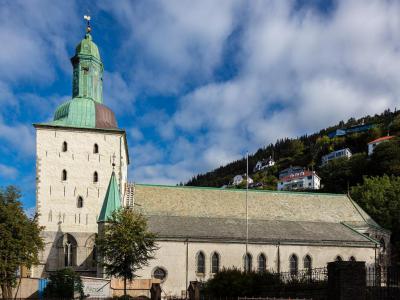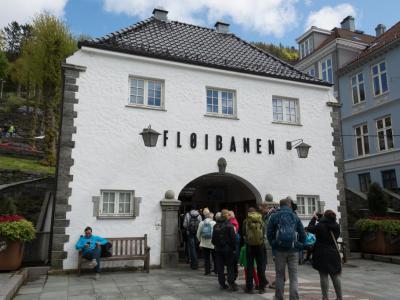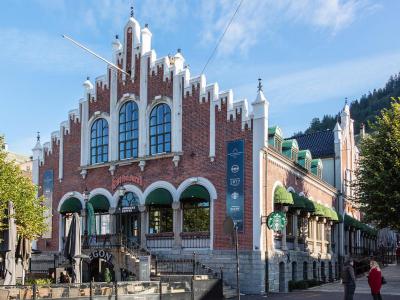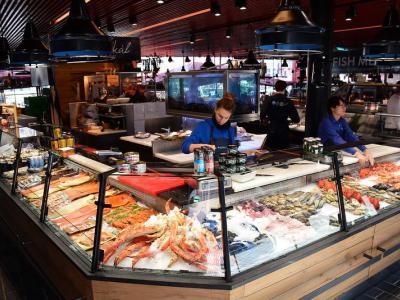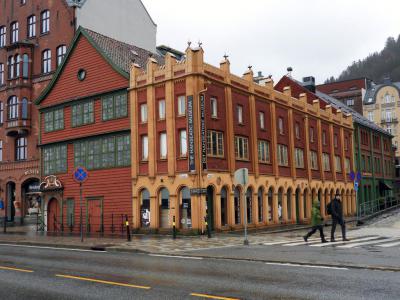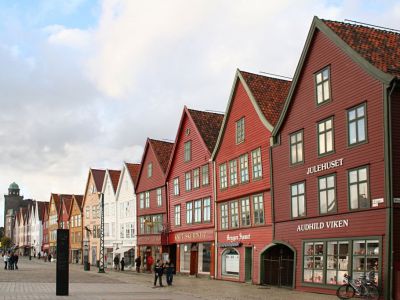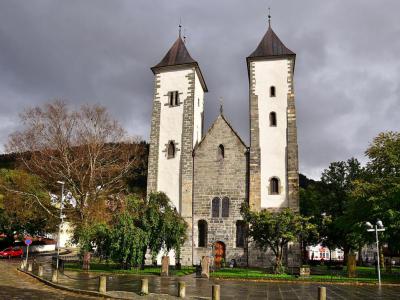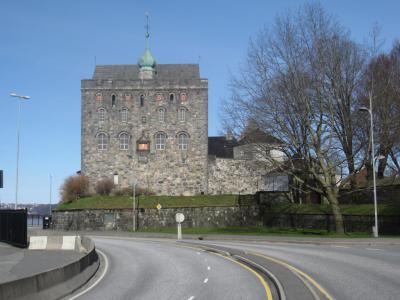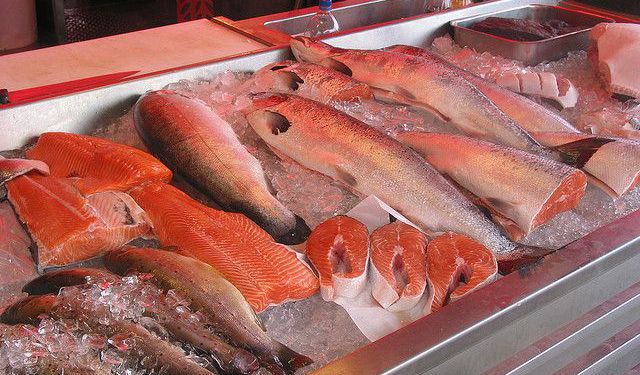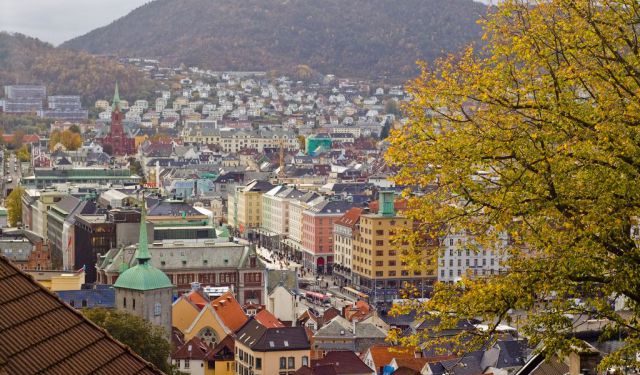
Bergen Introduction Walking Tour (Self Guided), Bergen
It is a wonder Bergen has had so many fires in its history, considering it has averaged 200 days a year of rain. So, why the fires?
Flames leapt across the narrow streets. The compact wooden buildings were easy prey. In 1702 90% of the city was destroyed. Disasters continued through the years. Finally, in 1916, a new idea in prevention emerged. The way to stop a fire was to starve it.
Torgallmenningen, the main square of Bergen, became a space wide enough to stall leaping flames. Narrow streets were widened and more squares created. Houses were rebuilt with stone and brick. Some hanseatic buildings in Bryggen were preserved.
Torgallmenningen is the largest and most central square. It is bound by buildings designed in the Scandinavian neoclassical style. At one end of the square is the Maritime Monument. It has statues of ancient Scandinavian seafarers, contemplating the tourists and the shops.
The Hansa in Bergen focused on trading grain for stockfish. The Hanseatic Wharf site in Bryggen is today a UNESCO World Heritage Site. It is home to a museum, shops, galleries, studios and restaurants.
A short walk away is the Fish Market, providing fresh fish since 1276. Seafood is the heart of Bergen cuisine.
KODE is one of the largest museums for art, design and music in Scandinavia. It is in four parts, KODE 1-4, a complex of art museums and composers' homes, joined.
Bergen is often called "the city of mountains." The most accessible peak is Floyen, 1,040 feet high. It can be reached by the Floibanen funicular, a six-minute ride.
The uniqueness of Bergen is its people. They say, "I'm not from Norway, I'm from Bergen."
Flames leapt across the narrow streets. The compact wooden buildings were easy prey. In 1702 90% of the city was destroyed. Disasters continued through the years. Finally, in 1916, a new idea in prevention emerged. The way to stop a fire was to starve it.
Torgallmenningen, the main square of Bergen, became a space wide enough to stall leaping flames. Narrow streets were widened and more squares created. Houses were rebuilt with stone and brick. Some hanseatic buildings in Bryggen were preserved.
Torgallmenningen is the largest and most central square. It is bound by buildings designed in the Scandinavian neoclassical style. At one end of the square is the Maritime Monument. It has statues of ancient Scandinavian seafarers, contemplating the tourists and the shops.
The Hansa in Bergen focused on trading grain for stockfish. The Hanseatic Wharf site in Bryggen is today a UNESCO World Heritage Site. It is home to a museum, shops, galleries, studios and restaurants.
A short walk away is the Fish Market, providing fresh fish since 1276. Seafood is the heart of Bergen cuisine.
KODE is one of the largest museums for art, design and music in Scandinavia. It is in four parts, KODE 1-4, a complex of art museums and composers' homes, joined.
Bergen is often called "the city of mountains." The most accessible peak is Floyen, 1,040 feet high. It can be reached by the Floibanen funicular, a six-minute ride.
The uniqueness of Bergen is its people. They say, "I'm not from Norway, I'm from Bergen."
How it works: Download the app "GPSmyCity: Walks in 1K+ Cities" from Apple App Store or Google Play Store to your mobile phone or tablet. The app turns your mobile device into a personal tour guide and its built-in GPS navigation functions guide you from one tour stop to next. The app works offline, so no data plan is needed when traveling abroad.
Bergen Introduction Walking Tour Map
Guide Name: Bergen Introduction Walking Tour
Guide Location: Norway » Bergen (See other walking tours in Bergen)
Guide Type: Self-guided Walking Tour (Sightseeing)
# of Attractions: 12
Tour Duration: 2 Hour(s)
Travel Distance: 3.0 Km or 1.9 Miles
Author: Caroline
Sight(s) Featured in This Guide:
Guide Location: Norway » Bergen (See other walking tours in Bergen)
Guide Type: Self-guided Walking Tour (Sightseeing)
# of Attractions: 12
Tour Duration: 2 Hour(s)
Travel Distance: 3.0 Km or 1.9 Miles
Author: Caroline
Sight(s) Featured in This Guide:
- Torgallmenningen Square
- Byparken (City Park)
- Kode Museums
- Kong Oscars Gate (King Oscars Street)
- Bergen Cathedral
- Floibanen Funicular
- Kjottbasaren Market
- Fish Market
- Hanseatic Museum
- Bryggen (The Wharf)
- St. Mary's Church
- Bergenhus Fortress and Rosenkrantz Tower
1) Torgallmenningen Square
The old days are not missed so much in Bergen, Norway. The city had a lot of wooden buildings, close together and narrow streets. Fires would break out with alarming regularity. Flames easily roared from one house to another, leaping across streets and engaging whole neighborhoods.
Something had to be done. The answer was "allmenninger", or rebuild vulnerable districts. Widen the streets and create squares between districts to stop the spread of fires. Torgallmenningen is Norway's "best designed town square."
It is near impossible to move around Bergen and not cross Torgallmenningen once or twice. Shops and malls line the square. Roofs of glass before the store facades protect shoppers from the all too frequent rains.
The Maritime Monument, with statues of Norwegian sea rovers, is at one end of the Square. These hardy sailors get no protection from the rain, but they don't mind. After all, it's only water.
"We'll meet at the blue Stone" is an expression often heard in Bergen, The Blue Stone is just that; a large blue stone that casts a spell. It is located at the intersection Of Torgallmenningen and Ole Busll Plass. It's a great place to meet.
Something had to be done. The answer was "allmenninger", or rebuild vulnerable districts. Widen the streets and create squares between districts to stop the spread of fires. Torgallmenningen is Norway's "best designed town square."
It is near impossible to move around Bergen and not cross Torgallmenningen once or twice. Shops and malls line the square. Roofs of glass before the store facades protect shoppers from the all too frequent rains.
The Maritime Monument, with statues of Norwegian sea rovers, is at one end of the Square. These hardy sailors get no protection from the rain, but they don't mind. After all, it's only water.
"We'll meet at the blue Stone" is an expression often heard in Bergen, The Blue Stone is just that; a large blue stone that casts a spell. It is located at the intersection Of Torgallmenningen and Ole Busll Plass. It's a great place to meet.
2) Byparken (City Park) (must see)
Byparken ("The City Park"), located in the very center of Bergen, is the city's first park. New municipal anti-fire regulations were put into effect in 1855. Following one more devastating fire, the city could not simply rebuild. A wide open space was needed to be a vast "fire break" in the middle of the city. Byparken was the answer.
The park is split in two. One side of the park has a light rail stop and the Music Pavilion, donated to the city. On the other side is the ever popular Festplassen ("party place"), an open-air venue for celebrations and events. Norwegian Constitution Day, on May 17, is observed here and The Festival of Light at Christmas.
Two large ponds are maintained in the park. They were once one pond but the middle part was filled in. The ponds remain connected however by an underground tunnel. Lungegardsvannet "Large lung" is the name for the larger pond. The smaller pond is Smalungeren "Small Lung." No surprise there.
The park is split in two. One side of the park has a light rail stop and the Music Pavilion, donated to the city. On the other side is the ever popular Festplassen ("party place"), an open-air venue for celebrations and events. Norwegian Constitution Day, on May 17, is observed here and The Festival of Light at Christmas.
Two large ponds are maintained in the park. They were once one pond but the middle part was filled in. The ponds remain connected however by an underground tunnel. Lungegardsvannet "Large lung" is the name for the larger pond. The smaller pond is Smalungeren "Small Lung." No surprise there.
3) Kode Museums (must see)
Alongside of Lille Lungegardsvannet or smalungeren or "Small Lung", the smaller pond of Byparken, is the Bergen Art Museum. The museum comes in a package of four, together referred to as Bergen Art Museum KODE. The art collection is divided by genre among four buildings, KODE 1-4. Let's go!
Start with KODE 4. This is the lion's share of the modern art collection. There is art from Diego Rivera, Joan Miro, and Pablo Picasso. Avant Garde works sit with paintings from the 14th century.
There is a children's area on the ground floor. It has a laboratory where children may experiment with art materials.
KODE 3, starring Rasmus Meyer. Meyer was an avid fan of Edvard Munch. Echoes of Munch's "Scream" can be detected in Meyer's works. "Jealousy", "Melancholy", "The Woman in Three Stages", and other paintings resonate with Munch's helpless fury. Also in KODE 3 are the works of J.C. Dahl, Harriet Backer, Erik Werenskiold, and Gerhard Munthe.
KODE 2 Houses Temporary Expositions. Once a year there will be something different inside KODE 2. Hungry? Try Smarkverket for a light linch, also inside KODE 2.
KODE 1, home of Precious Metals and International Antiques, is dedicated to craftsmanship and design. Currently the museum is the permanent home to a large gold and silver collection and the Singer collection of antiques. Lately 4,000 items and 780 Chinese works of art and handicrafts are on display.
Start with KODE 4. This is the lion's share of the modern art collection. There is art from Diego Rivera, Joan Miro, and Pablo Picasso. Avant Garde works sit with paintings from the 14th century.
There is a children's area on the ground floor. It has a laboratory where children may experiment with art materials.
KODE 3, starring Rasmus Meyer. Meyer was an avid fan of Edvard Munch. Echoes of Munch's "Scream" can be detected in Meyer's works. "Jealousy", "Melancholy", "The Woman in Three Stages", and other paintings resonate with Munch's helpless fury. Also in KODE 3 are the works of J.C. Dahl, Harriet Backer, Erik Werenskiold, and Gerhard Munthe.
KODE 2 Houses Temporary Expositions. Once a year there will be something different inside KODE 2. Hungry? Try Smarkverket for a light linch, also inside KODE 2.
KODE 1, home of Precious Metals and International Antiques, is dedicated to craftsmanship and design. Currently the museum is the permanent home to a large gold and silver collection and the Singer collection of antiques. Lately 4,000 items and 780 Chinese works of art and handicrafts are on display.
4) Kong Oscars Gate (King Oscars Street)
Named in honor of Oscar I, King of Norway and Sweden, in 1857. Prior to that date this street had a host of other names. It has been "shoemaker street", "tailor street", "hospital street", "St. Jacobs street", "Potrgaden", and "Domkirkegaden."
The street is narrower than most others in Bergen. At the south-eastern end is the old city gate of Bergen. A number of significant buildings line the street. At No. 67 King Oscars Street is Zander Kaae's Foundation, built in the 18th century for a charity and now it rents rooms to students.
St. Jorgen's Hospital was an 18th century leprosy hospital and now it is a leprosy museum. This is a sign that leprosy is down, an improvement, count your blessings. Next to the museum is Danekert Krohn's Foundation, another 18th century charity, this one for the elderly.
The street has its share of schools. There is Bergen katedralskole (cathedral school), one of three secondary schools on King Oscar Street. There are also Danielsen videregaende skole, and Tanks videregaende skole.
At the intersection of Lille Ovregate and Domkirkeplassen is Bergen Cathedral, a medieval church. Not far away is Holy Cross Church, also a medieval church.
A visit to King Oscars Street reveals a side of Bergen, hidden from ordinary sight. It is like a secret place, away from the chain shops and popular hang-outs. There are plenty shops and restaurants but they all have a personal style and charm that comes with the street.
The street is narrower than most others in Bergen. At the south-eastern end is the old city gate of Bergen. A number of significant buildings line the street. At No. 67 King Oscars Street is Zander Kaae's Foundation, built in the 18th century for a charity and now it rents rooms to students.
St. Jorgen's Hospital was an 18th century leprosy hospital and now it is a leprosy museum. This is a sign that leprosy is down, an improvement, count your blessings. Next to the museum is Danekert Krohn's Foundation, another 18th century charity, this one for the elderly.
The street has its share of schools. There is Bergen katedralskole (cathedral school), one of three secondary schools on King Oscar Street. There are also Danielsen videregaende skole, and Tanks videregaende skole.
At the intersection of Lille Ovregate and Domkirkeplassen is Bergen Cathedral, a medieval church. Not far away is Holy Cross Church, also a medieval church.
A visit to King Oscars Street reveals a side of Bergen, hidden from ordinary sight. It is like a secret place, away from the chain shops and popular hang-outs. There are plenty shops and restaurants but they all have a personal style and charm that comes with the street.
5) Bergen Cathedral
Since 12th century, Bergen Cathedral has been through the fire. Through the fire several times in fact, more than most, in a city famous for devastating fires. And to top it all off it has been hit by a cannon ball, which sticks in the wall to this day. Fires and wars, but there is peace and beauty inside.
Bergen Cathedral is episcopal seat of home parish of the Church of Norway. Word of the church appears for the first time in 1181. To this day it remains dedicated to Saint Olaf.
In 1181, Jon Kutiza, a peasant rebel and his men chased a number of King Sverre's men into the cathedral (then known as Olavskirken). Under the reign of King Haakon IV, Franciscans built a friary connecting to the church. The church had a long design in a Romanesque style. It burned down in 1248.
A new stone church was erected and that caught fire in 1270. The church wasn't fully reconstructed until 1537, when it was designated the new cathedral of the Protestant persuasion. In 1702 there was another fire and another reconstruction. By the 1880s the Cathedral's interior was restored to its original Rococo appearance.
In the second English-Dutch war, in the sea battle of Vagen in 1665, the cathedral sustained a hit from a cannon shot gone wild. The ball sits today, ensconced in the front wall.
The cathedral today is used mainly for musical events.
Bergen Cathedral is episcopal seat of home parish of the Church of Norway. Word of the church appears for the first time in 1181. To this day it remains dedicated to Saint Olaf.
In 1181, Jon Kutiza, a peasant rebel and his men chased a number of King Sverre's men into the cathedral (then known as Olavskirken). Under the reign of King Haakon IV, Franciscans built a friary connecting to the church. The church had a long design in a Romanesque style. It burned down in 1248.
A new stone church was erected and that caught fire in 1270. The church wasn't fully reconstructed until 1537, when it was designated the new cathedral of the Protestant persuasion. In 1702 there was another fire and another reconstruction. By the 1880s the Cathedral's interior was restored to its original Rococo appearance.
In the second English-Dutch war, in the sea battle of Vagen in 1665, the cathedral sustained a hit from a cannon shot gone wild. The ball sits today, ensconced in the front wall.
The cathedral today is used mainly for musical events.
6) Floibanen Funicular (must see)
The 100-year old carriages of the Floibanen funicular will take one from Bergen center to the top of Mount Floyen. It's a six minute ride to a fabulous panoramic view over the city, mountains and fjord.
Norway is a land of hiking and climbing. A ride in the funicular allows a visit to a place of uncountable opportunities for walks and hikes. Arriving visitors on Mount Floyen discover miles of gravel roads and paths. The paths lead to stunning overlooks of the fjord, the mountains and the city spread out below.
A trail called Vidden will take a hiker from Mount Floyen to Mount Ulriken. This popular hike takes about five hours. Most people prefer to hike from Ulriken to Mount Floyen. This is a path for more serious hikers. Mount Floyen has both short and long hikes. The trails are accessible to wheelchairs, strollers, young, and old.
Hungry pioneers need not suffer on the trail. On arriving at Floyen a visitor finds the Floisten shop offering pastry, ice cream and hot and cold drinks to the fasting voyageur. A short walk to Floien Folkerestaurant can get one a fuller meal and a spectacular view of things below.
A ten minute walk from the station find Lake Skomakerdiket and the cafe Skomakerstuen. Sit by the water and have a drink with your Norwegian "Svele", a griddle cake with sour cream.
There is an obstacle course and a large playground for children. For the adventurous, take a stroll though the Mysterious Troll Forest. Rent a motorbike or a canoe, not everything must involve hiking.
Why You Should Visit:
For the excitement. And yes, the views.
Tips:
With the Bergen Card round trips are free. Ask about discounts.
Norway is a land of hiking and climbing. A ride in the funicular allows a visit to a place of uncountable opportunities for walks and hikes. Arriving visitors on Mount Floyen discover miles of gravel roads and paths. The paths lead to stunning overlooks of the fjord, the mountains and the city spread out below.
A trail called Vidden will take a hiker from Mount Floyen to Mount Ulriken. This popular hike takes about five hours. Most people prefer to hike from Ulriken to Mount Floyen. This is a path for more serious hikers. Mount Floyen has both short and long hikes. The trails are accessible to wheelchairs, strollers, young, and old.
Hungry pioneers need not suffer on the trail. On arriving at Floyen a visitor finds the Floisten shop offering pastry, ice cream and hot and cold drinks to the fasting voyageur. A short walk to Floien Folkerestaurant can get one a fuller meal and a spectacular view of things below.
A ten minute walk from the station find Lake Skomakerdiket and the cafe Skomakerstuen. Sit by the water and have a drink with your Norwegian "Svele", a griddle cake with sour cream.
There is an obstacle course and a large playground for children. For the adventurous, take a stroll though the Mysterious Troll Forest. Rent a motorbike or a canoe, not everything must involve hiking.
Why You Should Visit:
For the excitement. And yes, the views.
Tips:
With the Bergen Card round trips are free. Ask about discounts.
7) Kjottbasaren Market
Kjottbasaren is Bergen's old meat market, founded in 1872. Just to the north of the Fish Market on Torget Street, is an ornate gabled brick building with a crenelated roof. This is Bergen's Kjottbasaren Market and food emporium. Originally specializing in meats, it now offers fruits and vegetables as well.
One can shop and dine here. Weather permitting, there will be tables and chairs in front of the cafe/restaurant. Be wary of the wind direction when digging into your waffles. The smell of fish from the neighboring fish market may put you off your feed.
Inside the market one is hemmed in by stalls selling chocolates, cheeses, meat, cakes and breads and souvenirs. The market was built in 1872 and restored in 1990. There are restaurants on the first floor and more stalls and shops above.
Kjottbasaren can be located at Vertlidsalmenningen number 2. Bon Appetit!
One can shop and dine here. Weather permitting, there will be tables and chairs in front of the cafe/restaurant. Be wary of the wind direction when digging into your waffles. The smell of fish from the neighboring fish market may put you off your feed.
Inside the market one is hemmed in by stalls selling chocolates, cheeses, meat, cakes and breads and souvenirs. The market was built in 1872 and restored in 1990. There are restaurants on the first floor and more stalls and shops above.
Kjottbasaren can be located at Vertlidsalmenningen number 2. Bon Appetit!
8) Fish Market (must see)
Nestling between the fjords and the seven mountains of Bergen, is the city's Fish Market. Besides fish and seafood, the market offers local farm products and fruit and vegetables. The restaurants, no surprise, sell a plentiful amount of seafood. The indoor market is open all year. The outdoor market opens in May for the summer.
The Fish Market has been in operation since 1200. It has always been a vital meeting place for fishermen, farmers, merchants and citizens. Fish are sold not only from shops in the Market, but also directly from boats at the quay.
The Fish Market was not always at the same location. The original market was next to Bryggen in the Nikolaikirkeallmanning. With the arrival of the Hanseatic League in the 14th century, the city became distinctly Germanic. In 1541 it was proposed strongly to move the market to keep the market free of Hanseatic influence.
Finally, in 1556 the Market was successfully moved to Vagen. The Market was then the central trading area of Bergen. In 2012 the indoor Fish Market was opened. The shops inside became permanent and business proceeded all year. The Market is now located at the inner harbor of Bergen, in the center of the city, easy to find.
Norway has a long convoluted coastline, stretching all the way to the Arctic. The fishing industry is extremely important to the local economy. Bergen is the the most active harbor in Norway with a busy and colorful fish market. It should not be missed.
Why You Should Visit:
"Why the fish alone are with the trip!"
The Fish Market has been in operation since 1200. It has always been a vital meeting place for fishermen, farmers, merchants and citizens. Fish are sold not only from shops in the Market, but also directly from boats at the quay.
The Fish Market was not always at the same location. The original market was next to Bryggen in the Nikolaikirkeallmanning. With the arrival of the Hanseatic League in the 14th century, the city became distinctly Germanic. In 1541 it was proposed strongly to move the market to keep the market free of Hanseatic influence.
Finally, in 1556 the Market was successfully moved to Vagen. The Market was then the central trading area of Bergen. In 2012 the indoor Fish Market was opened. The shops inside became permanent and business proceeded all year. The Market is now located at the inner harbor of Bergen, in the center of the city, easy to find.
Norway has a long convoluted coastline, stretching all the way to the Arctic. The fishing industry is extremely important to the local economy. Bergen is the the most active harbor in Norway with a busy and colorful fish market. It should not be missed.
Why You Should Visit:
"Why the fish alone are with the trip!"
9) Hanseatic Museum (must see)
In the 14th century the Hanseatic League reached Norway, They sailed to Bergen to open up a trade in grain for stockfish. Bergen soon became one of Northern Europe's trading centers. The Hanseatic Museum today belongs on UNESCO's World Heritage List.
The museum gives us a picture of how the Hanseatic merchant lived and influenced life in the Wharf. Walk through Bryggen today in the narrow alleyways and travel through time. See the men speaking Plattdeutsch and pushing barrels of stockfish to the quay. A group of 62 buildings from the Hanseatic era has been preserved.
The Hanseatic Assembly Rooms were originally single houses behind each Building on the wharf. The houses have names. Jakobsfjorden and Bellgaarden cover the period before 1702. Svensgaarden is from 1708. A third room, Bredsgaarden is from 1709 but it was rebuilt in 1761.
Hanseatic Assembly Rooms were part of the tenements. They were assembly rooms for company personnel in the winter. Only the assembly rooms were heated. Fire was forbidden in all other houses. Bergen was Fires-R-Us for centuries. An assembly room was a classroom for apprentices, church services, and funerals. Even punishments were meted out here.
The Hanseatic Assembly Rooms are next to the Hanseatic merchants' church, Saint Mary's Church.
The museum gives us a picture of how the Hanseatic merchant lived and influenced life in the Wharf. Walk through Bryggen today in the narrow alleyways and travel through time. See the men speaking Plattdeutsch and pushing barrels of stockfish to the quay. A group of 62 buildings from the Hanseatic era has been preserved.
The Hanseatic Assembly Rooms were originally single houses behind each Building on the wharf. The houses have names. Jakobsfjorden and Bellgaarden cover the period before 1702. Svensgaarden is from 1708. A third room, Bredsgaarden is from 1709 but it was rebuilt in 1761.
Hanseatic Assembly Rooms were part of the tenements. They were assembly rooms for company personnel in the winter. Only the assembly rooms were heated. Fire was forbidden in all other houses. Bergen was Fires-R-Us for centuries. An assembly room was a classroom for apprentices, church services, and funerals. Even punishments were meted out here.
The Hanseatic Assembly Rooms are next to the Hanseatic merchants' church, Saint Mary's Church.
10) Bryggen (The Wharf) (must see)
The Bryggen area originally covered all buildings between the sea and the Ovregaten road. The earliest pier is dated to about 1100 AD. The city of Bergen itself dates from before 1070. The existing buildings of Bryggen date no earlier than 1702. This is not surprising in a city so well acquainted with disastrous fires.
The Hanseatic League established itself in Bergen in 1350. They traded mostly cereal grains for stockfish. The town grew into an important center for international trade, and the buildings of Bryggen near the waterfront were, piece by piece, brought under the control of the Hanseatic merchants. The stockfish and the grains had found a home.
From 1702 until 1754 the Hanseatic league buildings were on fire, rebuilt, on fire, demolished, and on fire again. Finally the Hanseatic businesses in Bergen ended and the property at Bryggen was transferred to Norwegian citizens.
Bryggen suffered a fire again in 1955. In an archeological dig that followed, 670 ancient runic inscriptions were discovered carved mostly on pine chips or sticks. For a long time runes were thought to be used only for grave pronouncements or prayers.
These runes however, were concerned with more mundane day-to-day business. Such as: "Ast min, kyss mik." "My darling, kiss me." It is not known if the wish was granted. The inscriptions are at present held in Bryggens Museum in Bergen.
Hiding behind the classic Bryggen facades is a little world of alleyways, shops, galleries and studios. Local artists and designers have taken over the storage spaces for stockfish and grain. The rooms hold art, designs, jewelry, books and, wait for it, a cafe. Artists and designers are hiding in the narrow passeges among the houses.
The local artists want people to think of Bryggen not as some kind of museum where nothing happens, but a living thriving space for art.
Buildings at Bryggen that should be mentioned are Bellgarden (300 years old), Svensgarden, Ehnjorningsgarden, Bredsgarden, Bugarden, and Engelgarden. The tallest and oldest structure is Saint Mary's Church. Museums are Bryggen's Museum and Hanseatic Museum and Hanseatic Assembly Rooms.
Why You Should Visit:
To get a feeling of the Hanseatic influence on the city.
The Hanseatic League established itself in Bergen in 1350. They traded mostly cereal grains for stockfish. The town grew into an important center for international trade, and the buildings of Bryggen near the waterfront were, piece by piece, brought under the control of the Hanseatic merchants. The stockfish and the grains had found a home.
From 1702 until 1754 the Hanseatic league buildings were on fire, rebuilt, on fire, demolished, and on fire again. Finally the Hanseatic businesses in Bergen ended and the property at Bryggen was transferred to Norwegian citizens.
Bryggen suffered a fire again in 1955. In an archeological dig that followed, 670 ancient runic inscriptions were discovered carved mostly on pine chips or sticks. For a long time runes were thought to be used only for grave pronouncements or prayers.
These runes however, were concerned with more mundane day-to-day business. Such as: "Ast min, kyss mik." "My darling, kiss me." It is not known if the wish was granted. The inscriptions are at present held in Bryggens Museum in Bergen.
Hiding behind the classic Bryggen facades is a little world of alleyways, shops, galleries and studios. Local artists and designers have taken over the storage spaces for stockfish and grain. The rooms hold art, designs, jewelry, books and, wait for it, a cafe. Artists and designers are hiding in the narrow passeges among the houses.
The local artists want people to think of Bryggen not as some kind of museum where nothing happens, but a living thriving space for art.
Buildings at Bryggen that should be mentioned are Bellgarden (300 years old), Svensgarden, Ehnjorningsgarden, Bredsgarden, Bugarden, and Engelgarden. The tallest and oldest structure is Saint Mary's Church. Museums are Bryggen's Museum and Hanseatic Museum and Hanseatic Assembly Rooms.
Why You Should Visit:
To get a feeling of the Hanseatic influence on the city.
11) St. Mary's Church
St. Mary's church is a "long" style church of grey stone built around 1135. The architect is unknown but he would have been pleased to know his structure has withstood time and fortune so well. The church is used today and it seats about 240 people. It is definitely the oldest building in the City of Bergen.
St. Mary's is only survivor of the 12 churches and three monasteries that were built during the ring of Olav Kyrre (1066-1093). The church was probably built by craftsmen from Scania, in Denmark. The sryle of the church resembles that of Lund Cathedral in Scania.
The church was intended for the Norwegian people of Bergen, but it was taken over by the German population the town in 1408. It was locally named the "German" church and it served mainly the rich Hanseatic merchants. While it belonged to the Germans, St. Mary's prospered and did not fall into ruin like several other churches of Bergen.
In January 2010 major restoration work was undertaken. When finished the Church became associated with the Bergen Anglican denomination and began offering services in English.
The church has two towers and three naves and is mostly Romanesque in style. The choir is a bit Gothic like Haakon's Hall. The main building material is three grades of soapstone and some shale. The soapstone was likely quarried locally.
St. Mary's is only survivor of the 12 churches and three monasteries that were built during the ring of Olav Kyrre (1066-1093). The church was probably built by craftsmen from Scania, in Denmark. The sryle of the church resembles that of Lund Cathedral in Scania.
The church was intended for the Norwegian people of Bergen, but it was taken over by the German population the town in 1408. It was locally named the "German" church and it served mainly the rich Hanseatic merchants. While it belonged to the Germans, St. Mary's prospered and did not fall into ruin like several other churches of Bergen.
In January 2010 major restoration work was undertaken. When finished the Church became associated with the Bergen Anglican denomination and began offering services in English.
The church has two towers and three naves and is mostly Romanesque in style. The choir is a bit Gothic like Haakon's Hall. The main building material is three grades of soapstone and some shale. The soapstone was likely quarried locally.
12) Bergenhus Fortress and Rosenkrantz Tower (must see)
The tower and the Fortress must be thought of as one establishment. The Fortress has been a royal seat and residence, episcopal see and a military power base. The grounds within the walls of the island fortress are Holmen, Koengen and Sverresborg. The Fortress was built in the early 1500s. It was considered complete in 1700.
The Fortress was under siege only once during the second Dutch-English War. In August, 1665, a squadron of Dutch vessels took shelter in neutral Bergen Harbor. The neutrality was not respected. The English warships fired on the Dutch ships and the Fortress. Fire was returned. The battle was a short one. It came to be known as The Battle of Vagen.
The English were attacking vessels of the Dutch East India Company. The attack failed. No ships were sunk. In the Second World War Bergenhus was once again in service. This time however it was a German occupying force that used the fort as their western headquarters.
Begenhus has been a military facility without interruption since 1628. Presently 220 military and civilian personnel are stationed at the fort.
The Rosenkrantz Tower is the dominant building of the fort complex. It was named for governor Erik Rosenkrantz. The tower got its present form during Rosenkrantz's reign, 1559-1568. There is a yet older part of the tower. It is a medieval tower called the "keep by the Sea." It was built by King Magnus the Lawmaker in 1270.
Rosenkrantz's building held dungeons on the first floor and cannons on the roof. With residential rooms in between it must have been insufferably loud in a battle. Not a good place for meditation.
The other medieval structure to remain is Haakon's Hall, built about 1270. It was incorporated in Rosenkrantz's Tower. Several Churches, including Bergen's Christ Church were included in the premises. The churches were demolished by 1531 and the isle of Holmen became strictly military.
The Fortress was under siege only once during the second Dutch-English War. In August, 1665, a squadron of Dutch vessels took shelter in neutral Bergen Harbor. The neutrality was not respected. The English warships fired on the Dutch ships and the Fortress. Fire was returned. The battle was a short one. It came to be known as The Battle of Vagen.
The English were attacking vessels of the Dutch East India Company. The attack failed. No ships were sunk. In the Second World War Bergenhus was once again in service. This time however it was a German occupying force that used the fort as their western headquarters.
Begenhus has been a military facility without interruption since 1628. Presently 220 military and civilian personnel are stationed at the fort.
The Rosenkrantz Tower is the dominant building of the fort complex. It was named for governor Erik Rosenkrantz. The tower got its present form during Rosenkrantz's reign, 1559-1568. There is a yet older part of the tower. It is a medieval tower called the "keep by the Sea." It was built by King Magnus the Lawmaker in 1270.
Rosenkrantz's building held dungeons on the first floor and cannons on the roof. With residential rooms in between it must have been insufferably loud in a battle. Not a good place for meditation.
The other medieval structure to remain is Haakon's Hall, built about 1270. It was incorporated in Rosenkrantz's Tower. Several Churches, including Bergen's Christ Church were included in the premises. The churches were demolished by 1531 and the isle of Holmen became strictly military.
Walking Tours in Bergen, Norway
Create Your Own Walk in Bergen
Creating your own self-guided walk in Bergen is easy and fun. Choose the city attractions that you want to see and a walk route map will be created just for you. You can even set your hotel as the start point of the walk.
Bergen Shopping Tour
For centuries, since its establishment in the 1020s, Bergen has been an important commercial hub. As such, it is probably one of the oldest shopping destinations in Northern Europe. Today, Bergen features a variety of shops and markets scattered throughout the city.
One such notable location is Kjottbasaren, a historic market located near the city center. Here, visitors can explore a variety... view more
Tour Duration: 1 Hour(s)
Travel Distance: 0.9 Km or 0.6 Miles
One such notable location is Kjottbasaren, a historic market located near the city center. Here, visitors can explore a variety... view more
Tour Duration: 1 Hour(s)
Travel Distance: 0.9 Km or 0.6 Miles
Bergen's Architectural Jewels
Surprising as it may appear, but the seemingly small city of Bergen for centuries had been the largest in all of the Nordic countries. It also remained so for Norway until the 1830s. Apart from being the country's former capital (back in the 13th century), Bergen is well-known primarily for its astoundingly beautiful cityscape, formed by the backdrop of mountains and serene waterfront, much... view more
Tour Duration: 2 Hour(s)
Travel Distance: 2.9 Km or 1.8 Miles
Tour Duration: 2 Hour(s)
Travel Distance: 2.9 Km or 1.8 Miles
The Most Popular Cities
/ view all
